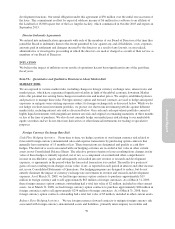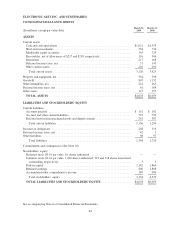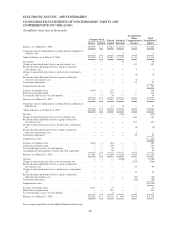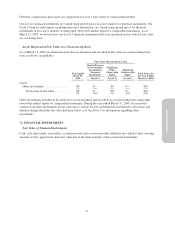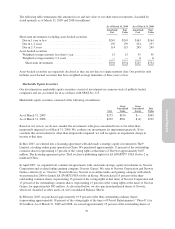Electronic Arts 2009 Annual Report Download - page 149
Download and view the complete annual report
Please find page 149 of the 2009 Electronic Arts annual report below. You can navigate through the pages in the report by either clicking on the pages listed below, or by using the keyword search tool below to find specific information within the annual report.
Annual Report
Cash, Cash Equivalents, Short-Term Investments, Marketable Equity Securities and Other Investments
Cash equivalents consist of highly liquid investments with insignificant interest rate risk and original or
remaining maturities of three months or less at the time of purchase.
Short-term investments consist of securities with original or remaining maturities of greater than three months at
the time of purchase. The short-term investments are available for use in current operations or other activities
such as capital expenditures and business acquisitions.
Marketable equity securities consist of investments in common stock of publicly traded companies and are
accounted for in accordance with Statement of Financial Accounting Standard (“SFAS”) No. 115, Accounting for
Certain Investments in Debt and Equity Securities, as amended.
As of March 31, 2009 and March 31, 2008, short-term investments and marketable equity securities were
classified as available-for-sale and stated at fair value. We evaluate our short-term investments and marketable
equity securities for impairment, in accordance with SFAS No. 115, as amended. Unrealized gains and losses on
our short-term investments and marketable equity securities are recorded to other comprehensive income, net of
tax, until either the securities are sold or we determine that the decline in the fair values below their cost basis are
other-than-temporary. Realized gains and losses are calculated based on the specific identification method.
Determining whether the decline in fair value is other-than-temporary requires management judgment based on
the specific facts and circumstances of each security. The ultimate value realized on these securities is subject to
market price volatility until they are sold. We consider various factors in determining whether we should
recognize an impairment charge, including the duration that the fair value has been less than the cost basis,
severity of the impairment, reason for the decline in value and potential recovery period, the financial condition
and near-term prospects of the investees, and our intent and ability to hold the investment for a period of time
sufficient to allow for any anticipated recovery in market value.
Other investments, included in other assets on our Consolidated Balance Sheets, consist principally of non-voting
preferred shares in two companies whose common stock is publicly traded and are accounted for under the cost
method in accordance with Accounting Principles Board Opinion (“APB”) No. 18, The Equity Method Of
Accounting For Investments In Common Stock, as amended. The cost method of accounting is used for
investments where we are not able to exercise significant influence over the operating and financing decisions of
the investee. We monitor these investments for impairment and make appropriate reductions in the carrying
values if we determine that an impairment charge is required, based primarily on the financial condition and
near-term prospects of the investees.
Inventories
Inventories consist of materials (including manufacturing royalties paid to console manufacturers), labor and
freight-in and are stated at the lower of cost (first-in, first-out method) or market value. We regularly review
inventory quantities on-hand and in the retail channel. We write down inventory based on excess or obsolete
inventories determined primarily by future anticipated demand for our products. Inventory write-downs are
measured as the difference between the cost of the inventory and market value, based upon assumptions about
future demand that are inherently difficult to assess. At the point of a loss recognition, a new, lower cost basis for
that inventory is established, and subsequent changes in facts and circumstances do not result in the restoration or
increase in that newly established basis.
Property and Equipment, Net
Property and equipment, net, are stated at cost. Depreciation is calculated using the straight-line method over the
following useful lives:
Buildings ..................................... 20to25years
Computer equipment and software ................. 3to5years
Furniture and equipment ......................... 3to5years
Leasehold improvements ......................... Lesser of the lease term or the estimated useful lives
of the improvements, generally 1 to 10 years
69


